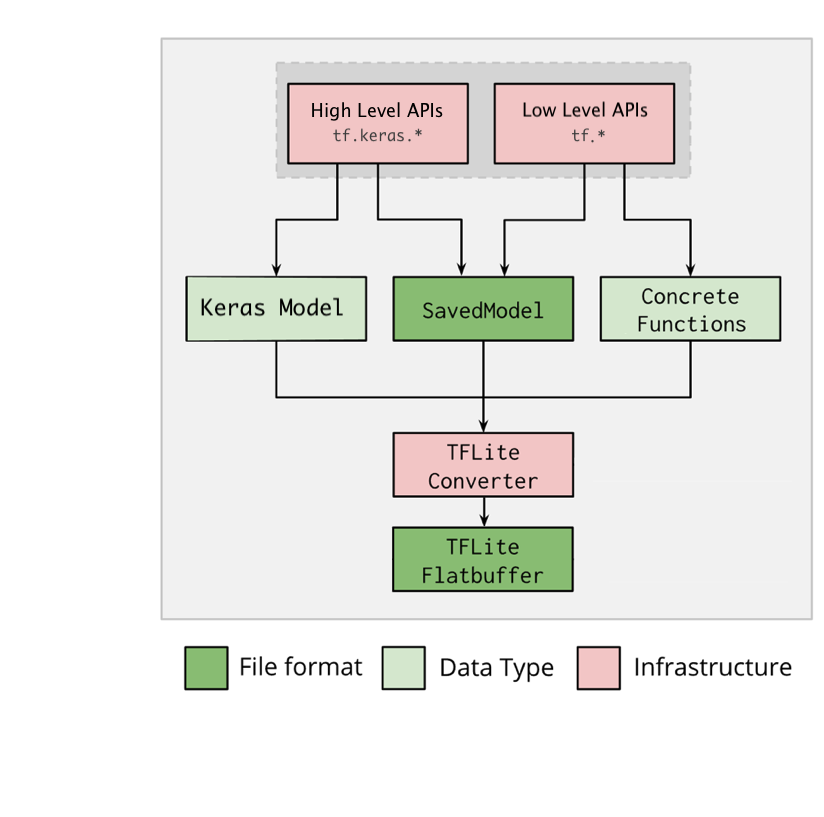TensorFlow Lite 변환기는 TensorFlow 모델을 사용하고 TensorFlow Lite 모델(.tflite 파일 확장자로 식별되는 최적화된 FlatBuffer 형식)을 생성합니다. 변환기를 사용하는 옵션에는 다음 두 가지가 있습니다.
- Python API(권장): 모델 개발 파이프라인의 일부로 모델을 더 쉽게 변환하고 최적화를 적용하며 메타데이터를 추가하는 등 다양한 기능이 많습니다.
- 명령줄: 기본 모델 변환만 지원합니다.

Python API
도우미 코드: 설치된 TensorFlow 버전을 확인하려면 print(tf.__version__)를 실행하고 TensorFlow Lite 변환기 API에 관해 자세히 알아보려면 print(help(tf.lite.TFLiteConverter))를 실행합니다.
TensorFlow 2.x를 설치한 경우 옵션에는 다음 두 가지가 있습니다. TensorFlow 1.x를 설치한 경우 GitHub를 참고하세요.
tf.lite.TFLiteConverter를 사용하여 TensorFlow 2.x 모델을 변환합니다. TensorFlow 2.x 모델은 저장된 모델 형식을 사용하여 저장되며 상위 수준tf.keras.*API(Keras 모델) 또는 하위 수준tf.*API(여기서 구체적 함수 생성)를 사용하여 생성됩니다. 따라서 다음 세 가지 옵션이 있습니다. 예는 다음 몇 가지 섹션을 참고하세요.tf.lite.TFLiteConverter.from_saved_model()(권장): 저장된 모델을 변환합니다.tf.lite.TFLiteConverter.from_keras_model(): Keras 모델을 변환합니다.tf.lite.TFLiteConverter.from_concrete_functions(): concrete 함수를 변환합니다.
tf.compat.v1.lite.TFLiteConverter를 사용하여 TensorFlow 1.x 모델을 변환합니다(예는 GitHub 참고).tf.compat.v1.lite.TFLiteConverter.from_saved_model(): 저장된 모델을 변환합니다.tf.compat.v1.lite.TFLiteConverter.from_keras_model_file(): Keras 모델을 변환합니다.tf.compat.v1.lite.TFLiteConverter.from_session(): 세션에서 GraphDef를 변환합니다.tf.compat.v1.lite.TFLiteConverter.from_frozen_graph(): 파일에서 Frozen GraphDef를 변환합니다. 체크포인트가 있으면 먼저 체크포인트를 Frozen GraphDef 파일로 변환한 후 여기를 참고하여 이 API를 사용합니다.
저장된 모델 변환(권장)
다음 예는 저장된 모델을 TensorFlow Lite 모델로 변환하는 방법을 보여줍니다.
import tensorflow as tf
# Convert the model
converter = tf.lite.TFLiteConverter.from_saved_model(saved_model_dir) # path to the SavedModel directory
tflite_model = converter.convert()
# Save the model.
with open('model.tflite', 'wb') as f:
f.write(tflite_model)
Keras 모델 변환
다음 예는 Keras 모델을 TensorFlow Lite 모델로 변환하는 방법을 보여줍니다.
import tensorflow as tf
# Create a model using high-level tf.keras.* APIs
model = tf.keras.models.Sequential([
tf.keras.layers.Dense(units=1, input_shape=[1]),
tf.keras.layers.Dense(units=16, activation='relu'),
tf.keras.layers.Dense(units=1)
])
model.compile(optimizer='sgd', loss='mean_squared_error') # compile the model
model.fit(x=[-1, 0, 1], y=[-3, -1, 1], epochs=5) # train the model
# (to generate a SavedModel) tf.saved_model.save(model, "saved_model_keras_dir")
# Convert the model.
converter = tf.lite.TFLiteConverter.from_keras_model(model)
tflite_model = converter.convert()
# Save the model.
with open('model.tflite', 'wb') as f:
f.write(tflite_model)
concrete 함수 변환
다음 예는 concrete 함수를 TensorFlow Lite 모델로 변환하는 방법을 보여줍니다.
import tensorflow as tf
# Create a model using low-level tf.* APIs
class Squared(tf.Module):
@tf.function(input_signature=[tf.TensorSpec(shape=[None], dtype=tf.float32)])
def __call__(self, x):
return tf.square(x)
model = Squared()
# (ro run your model) result = Squared(5.0) # This prints "25.0"
# (to generate a SavedModel) tf.saved_model.save(model, "saved_model_tf_dir")
concrete_func = model.__call__.get_concrete_function()
# Convert the model.
# Notes that for the versions earlier than TensorFlow 2.7, the
# from_concrete_functions API is able to work when there is only the first
# argument given:
# > converter = tf.lite.TFLiteConverter.from_concrete_functions([concrete_func])
converter = tf.lite.TFLiteConverter.from_concrete_functions([concrete_func],
model)
tflite_model = converter.convert()
# Save the model.
with open('model.tflite', 'wb') as f:
f.write(tflite_model)
기타 기능
최적화 적용: 일반적으로 사용되는 최적화는 학습 후 양자화로, 정확성을 최소한으로 손실하면서 모델 지연 시간과 크기를 추가로 줄일 수 있습니다.
기기에 모델을 배포할 때 플랫폼별 래퍼 코드를 더 쉽게 만들 수 있는 메타데이터를 추가합니다.
변환 오류
다음은 일반적인 변환 오류와 해결 방법입니다.
오류:
Some ops are not supported by the native TFLite runtime, you can enable TF kernels fallback using TF Select. See instructions: <a href="https://www.tensorflow.org/lite/guide/ops_select">https://www.tensorflow.org/lite/guide/ops_select</a> TF Select ops: ..., .., ...해결 방법: 이 오류는 모델에 TFLite 구현에 대응하지 않는 TF 작업이 있기 때문에 발생합니다. TFLite 모델에서 TF 작업을 사용하여 이 문제를 해결할 수 있습니다(권장). TFLite 작업만으로 모델을 생성하려면 GitHub 문제 #21526에 누락된 TFLite 작업 요청을 추가하거나(요청한 적이 있다면 댓글을 남겨야 함) 직접 TFLite 작업을 생성하면 됩니다.
오류:
.. is neither a custom op nor a flex op해결 방법: TF 작업에 따라 다음과 같이 나누어집니다.
TF에서 지원하는 경우: 이 오류는 TF 작업이 허용 목록(TFLite에서 지원하는 전체 TF 작업 목록)에서 누락되었기 때문에 발생합니다. 이 문제는 다음과 같이 해결할 수 있습니다.
TF에서 지원하지 않는 경우: 이 오류는 사용자가 정의한 맞춤 TF 연산자를 TFLite가 인식하지 못하기 때문에 발생합니다. 이 문제는 다음과 같이 해결할 수 있습니다.
- TF 작업을 만듭니다.
- TF 모델을 TFLite 모델로 변환합니다.
- TFLite 작업을 만들고 이를 TFLite 런타임에 연결하여 추론을 실행합니다.
명령줄 도구
가능하면 위에 나열된 Python API를 대신 사용하는 것이 좋습니다.
pip에서 TensorFlow 2.x를 설치한 경우 다음과 같이 tflite_convert 명령어를 사용합니다. 소스에서 TensorFlow 2.x를 설치한 경우 다음 섹션에서 'tflite_convert'를 'bazel run
//tensorflow/lite/python:tflite_convert --'로 대체하면 되고 TensorFlow 1.x를 설치한 경우 GitHub(참조, 예)를 참고하세요.
tflite_convert: 사용 가능한 모든 플래그를 보려면 다음 명령어를 사용합니다.
$ tflite_convert --help
`--output_file`. Type: string. Full path of the output file.
`--saved_model_dir`. Type: string. Full path to the SavedModel directory.
`--keras_model_file`. Type: string. Full path to the Keras H5 model file.
`--enable_v1_converter`. Type: bool. (default False) Enables the converter and flags used in TF 1.x instead of TF 2.x.
You are required to provide the `--output_file` flag and either the `--saved_model_dir` or `--keras_model_file` flag.
저장된 모델 변환
tflite_convert \
--saved_model_dir=/tmp/mobilenet_saved_model \
--output_file=/tmp/mobilenet.tflite
Keras H5 모델 변환
tflite_convert \
--keras_model_file=/tmp/mobilenet_keras_model.h5 \
--output_file=/tmp/mobilenet.tflite
다음 단계
TensorFlow Lite 인터프리터를 사용하여 클라이언트 기기(예: 모바일, 삽입형)에서 추론을 실행합니다.
